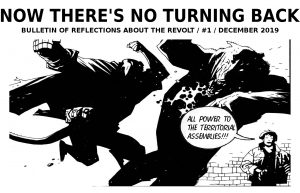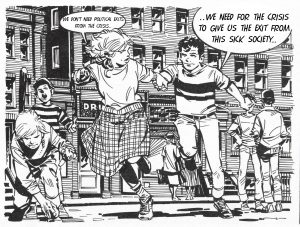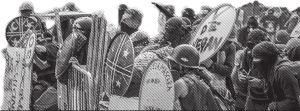Here is a translation of “Ya No Hay Vuelta Atrás”, the first issue of a bulletin published in early december (which appears to have been written in the context of late november) about the Chilean revolt and the need for the territorial assemblies to reject attempts at recuperation as embodied by the so-called Constituent Process and to assert their autonomy outside of and against all State institutions. Again it’s been attempted to maintain the format of the original publication.
Screen Reading – Formatted for printing
Plaintext version (including the detourned graphics) follows:

CONSTITUTIONAL CONVENTION OR AUTONOMOUS TERRITORIAL ASSEMBLIES?
The rebellion of 10/18 was spontaneous, popular, massive, and anarchic. The “decompression valve” that they try to install from above is hierarchical, elitist, institutional and “democratic”.
In effect, it would appear that this insurrection at a national level has almost no historical precedents. Perhaps two outbreaks which it notoriously has most in common with would be those from april of 1957 in Valparaíso, Concepción and Santiago, and the occupations movement in France of May/June 1968.
In the first movement, the proletariat of those three cities arose spontaneously with a slight temporal gap (30th of March in Valparaíso, 1st of April in Concepción and 2nd of April in Santiago) because of a transport price hike, triggering a brief and intense insurrection which, in order to defeat it, obliged taking the police off the streets and bringing in the Army. Many dozens died, and the government backed down from the price hike [1]. In the second, the heavy repression of the student movement generated a spontaneous general strike, which was boycotted by the bourgeois parties (above all by the French “Communist” Party) and their unions. After a month of an authentic popular explosion of creativity and street fighting with the police, the movement began to decline when the party of order reorganized, including massive demonstrations for social peace and finally arriving to economic reform agreements between the bosses, the unions and the government. There were one or two deaths during the whole process (lives are worth less the further one goes into the Third world), and the outbreak of ’68 acquired a global dimension (USA, Córdoba, Mexico, Japan, Czechoslovakia, and many more…) [2].
But no revolt is the same as the other -though in all of these a suspension of the temporality and the normality installed by the social order were produced- and the one of 10/18 seems to have been a unique event. Despite the “outbreak” having been foreseeable for awhile (as many generals now affirm after the battle) it was impossible to calculate how and when it would happen, and that even less that a month and a half after this eruption, this horizontal and multi-form assault on capitalist normality, we would continue in the streets in spite of everything.
In any case, if we look at other current processes like the protests in Hong Kong and France, it would appear that in this new global wave of rebellions against the system of domination the insurrections no longer have a “conquest of power” as their horizon (as it was understood from the perspective of the bourgeois revolutions: by means of the seizing of state power), but they are truly “permanent insurrections”, which at the same time as they challenge power, try to construct a human community that prefigures other forms of living.
II
What is indeed a foreseeable and almost “out of the book” maneuver is the response orchestrated from above. Three weeks after the “declaration of War” made by the billionaire President, with all its disastrous consequences, we could see, reunited in a Palace, the whole “political class” – a curious concept since they are all really expressions of the politics of one single class, the bourgeoisie, however much professional politicians tend to constitute a kind of separate caste – which unified hurriedly enough under the heavy pressure, from the popular rebellion on one side and the demands of the Economy and the state-military mafia on the other, in order to proclaim, at the break of dawn, the “Accord for Peace and the New Constitution”. All together in the effort to re-legitimize the “chilean model” of the State and capitalism, and without pronouncing a single word about the explanation and punishment of the massive and systematic practices of violation of human rights by the Carabineros, under the command of the infamous General Director Mario Rozas, and of which also Pera, Chadwick, Iturriaga and Espina are responsible.
Obviously, when negotiating with criminals against humanity, they are recognized as valid interlocutors and their political and criminal responsibility remains in the dark. In this the much touted Accord displays the very seal of the chilean dominant class, taking as its model the inter-bourgeois negotiations of the late 80’s which paved the way for the “transition”.
III
Some official analysts speak openly about how the objective of the accords that were negotiated on the 15th of November is the “Pacification” of the conflict, which they judge to be relatively successful since then. Minister Blumel points out that each day there are less demonstrations and arrests. But the proletarian youth don’t abandon the street, they have learned to fight massively against the henchmen of the GOPE/Special Forces (“Comando Jungla” in the city), they have attacked and felled the worst symbolic monuments of domination within the territory reconquered every day by “the horde”, and in addition to adrenalin and fighting spirit they are clearly conscious that what was achieved was thanks to the direct action of the masses, and not negotiations, agreements, votes or ballots. The editorial from “El Mercurio” of the 21st of November also evaluates the labor of “constitutional” political contention as a relative success as the effect of this accord, and takes the opinion that the discrepancies observed “appear to be generally directed towards the sphere of politics and inside of an institutional framework.” But the “normalization” of the violence is bitterly complained about:
“Every day new lootings of shops and even medical centers are produced. Demonstrations by students continue to disrupt the operation of the the metro, and even yesterday new mass evasions had been noticed. Finally, dangerously, mass aggressions against police functionaries have begun to take place.“
The Editorial of “El Mercurio“, the orientational organ of bourgeois politics that it is, concludes by calling attention to the “legitimizers” of popular violence. And already we’re seeing attempts to direct complaints, coming from the Ministry of the Interior and by the Law of State Security, against those who agitate in favor of the overthrow of the government.
Could the “constituent” farce which is announced and which stirs such enthusiasm in all the good hearted social-democrats and juridical fetishists contain and channel the energies of the popular rebellion? Could they tame the acratic force in order to turn it into democracy?
We believe that it won’t be so easy, but it will depend on how we organize from now on, from the counter-power generated spontaneously in the streets, and the objectives that we aim for as a class/species, outside of and against all the parcels of “separate power”.
In any case, what’s clear is that the territorial assemblies are organs which have been created since 18th of October by the communities in struggle. Our place is there, where we will have to on one hand openly discuss with those who more or less conscientiously embrace institutionalist and social-democratic positions, which are expressed up until now as a feeling of being majorly in favor of a “constituent process”.
But it’s not just that: the greatest potential of the territorial assemblies, in the measure in which they maintain their autonomy, acting outside of and against the State, has to do with issues and tasks of practical order (self-defense, nourishment, communications, caring for children and the elderly) which must be pushed to their limits in order to be able to present, stemming from them, communizing objectives. The assemblies are the place from which new forms of social relations can arise which can overcome and cast capitalist social relations to the dustbin of history. It’s becoming necessary to coordinate all of them.
V
This agreement makes the current society’s tendency towards “politicism”[3] evident: what always appears on the surface, the tip of the iceberg of the society, is the system of domination in its face of political “institutions” and representative democracy. Marx clearly said that “revolutions are not made with laws“, but the leftist/democratic citizenry dreams of changing the country by means of a great “Social Pact”.
Molding their “dreams” upon the great Table of the Law, they believe that the economic and social base of the system will change in following with the magic wand of “constituent power”. An evident proof of this is that the dominant class wagers on deactivating the tension with policial and “constituent” measures, but what remains clearly in the clouds is everything relative to the “social agenda” with which they claimed they would go on to resolve the grave injustices and abuses against which the people rebelled massively a month ago.
However, some official analysts are clear that the re-installation of the Social Peace depends on both agendas: “Two challenges peek out on the immediate horizon. The most urgent one is the capacity of the political class to be able to construct an accord about pensions, minimum wage and debt, to cite a few of the demands felt by the demonstrators. If there’s not a rapid response to that, the movement could reactivate. The other challenge is how to guarantee the widest participation in regard to the initial plebiscite“.

VI
“Spontaneity” is not the opposite of conscious organization. According to Marx “the proletarian party is born spontaneously from the historic ground of the modern society“. Obviously this historical party has nothing to do with the Party-institution that traditional social-democracy and later the radicalized or leninist one have left to history, in a conception that has arrived to be dominant in which “spontaneity” and “consciousness” are placed in opposition. The revolutionary proletarian movement is, in effect, “spontaneous”, but not only in the sense that when it manifests (Russia, 1917; Spain, 1936) it’s a revolution without bosses, which doesn’t wait for orders from above, but furthermore in the sense that “these movements of the proletariat are totally determined by the situation which this class occupies in the ensemble of the social relations fundamental to the modern society, and at a particular juncture which, during a given period, bestows it the occasion to intervene on the scene“[4].
Consciousness is not opposed to this spontaneity -contrary to what was believed since the 2nd International (by Kautsky), and since the 3rd (by his disciple Lenin), with the thesis that it’s necessary to introduce an “external consciousness” in the proletariat-, but “the proletariat acquires, because it needs to, the consciousness of itself, meaning the clear representation of its situation, from its relations with the other classes and from its role” and “because of its situation in the capitalist relations of production, the working class is the only one which bears, as a class, socialist consciousness“.[5]
The chilean rebellion was initiated by the proletarian youth, but in striking the match and extending immediately to the whole country, it was taken up by the entirety of the people. Where it still hasn’t managed to express itself substantially is in the centers of production, in the workplaces, save for a few exceptions, with “trade” movements and initiatives generally controlled by the unions. It’s not necessary to be “workerists” in order to take into account that this has been a vital limitation of the movement up until now.
What’s clear is that in a month of struggle the level of consciousness has increased notably, as it has always been said to happen in these processes, and from the critique of the model -the so-called “neoliberal” one- it passed on to the critique of the (capitalist) system, of its way of life and the systematically noxious elements that it generates.
In effect, what sprouts up from the streets since the 18th of October is nothing less than life, in its different expressions. Not only is it no coincidence that there don’t exist “bosses”, but it’s of deep importance that the greatest icon of the movement is a non-human animal: the legendary dog who for years accompanied us in the streets and is known as “Negro Matapacos” [Black Copkiller]. The social revolution gives a possibility to humanity to reconcile with itself, with the other animals and with nature.
VII
Now a month after the beginning of the rebellion there a few things that are becoming clear. The terrorist character of the State stands bare, and it has demonstrated that the only power of our class is in the streets, through massive protests and a “front line” of hundreds of youths that rise to face the repression and have learned to defend themselves and to attack, individually and collectively, so guaranteeing that thousands can remain in the streets despite the brutal onslaughts of the police. What’s surprising is the major presence of propaganda and assertions directed towards demanding freedom for the large quantity of comrades who have been locked up in the jails by means of preventive prison sentences, and who have suffered evident abuse at the hands of the District Attorney and the Tribunals.
It’s necessary to demand their immediate and unconditional release, regardless of what type of offense they were charged with. And as a counterbalance, without falling into the trap of bestowing any confidence to the State, we must demand explanations and punishment for all the human rights violations committed by the military and police, and on the basis of their generalized and systematic character, to raise the demand that the highest levels of the government and the State be held responsible.
VIII
Many anti-capitalist comrades (but not necessarily anti-authoritarians) look well upon the “constituent” space. They point out, for example, that “despite the fact that the Assembly will not be what puts an end to the the capitalist mode of production in Chile, it is indeed the instance which, on one hand, if it manages to reverse the accord concluded by the party of order, it will open the path to putting an end to this political period and to start a new one with the working class as its protagonist, advancing much more rapidly than it has done in recent decades; and on the other hand, it could allow gaining and consecrating a series of demands that have been born from the recent years of social mobilizations.
These conquests must materialize, given that in this manner what the struggle gives can be tasted, and that only with organization does it advance“.
We’re not in agreement: it’s been demonstrated once more that the path to put an end to patriarchal/state/capitalist domination is not the integration of the popular demands into the specialized political sphere, but that the direct action of the masses in the streets and plazas of the country. Why should it be needed to go and “try” this by means of the approval of laws and constitutions which are precisely the language of the State that we are trying to annul and destroy? And if the idea is to “integrate the working class” (understood in the most workerist and traditional way), why is it the “constituent” space, and not the direct, frontal struggle which could convoke them?
We don’t remain in the territorial assemblies because of the fact that within them the demand for the Constituent Assembly is expressed. But it’s clear to us that it is not our terrain. What we will do in these spaces will be to propose the abolition of the existing social order, by means of destituent demands, starting with the dissolution of the Carabineros de Chile [national police], and especially their “Comando Jungla”(GOPE and FFEE) [Special Forces], the abolition of the SENAME [Child Services], freedom for all the prisoners from the revolt, etc.
From there, our program of abolitions (of the State, money, of the police) must begin to mold itself with clarity and coherence.
★

notes:
1. There exists a very well documented book on this subject, Historia y memoria. 2 de abril de 1957 by the historian Pedro Milos, published by Lom Ediciones, and a brief report in Comunismo Difuso n.2-3.
2. About ’68 in France, see the book Enragés and Situationists in the Occupations Movement, by René Viénet, available online [in english at the Situationist International Online:
https://www.cddc.vt.edu/sionline/si/enrages.html ]
2. On the new global scenario which opened up on that year, see “The Beginning of an Era” in Internationale Situationniste n.12 (September 1969). [ https://www.cddc.vt.edu/sionline/si/beginning.html ]
3. On the classical and symmetrical deviations of the social-democratic conception of the transition to socialism, managerialism and politicism, see the book La contrarrevolución rusa y el desarrollo del capitalismo by the Internationalist Communist Group (GCI-ICG), especially the chapter El politicismo contra la revolución (pp. 27-39). There it is affirmed that “For the politicists, the economy is really a different issue, and therefore, despite being such ‘revolutionaries’ in politics they are not only such reformists (counterrevolutionaries) in the socioeconomic (no attack on capital at all, but seeking its state-juridical centralization), but without exception they end up sneaking in through the window what they said they were kicking out the door: managerialism“.
4. Denis Authier, Preface to León Trotsky (2002) Informe de la delegación siberiana. Trotsky contra Lenin. Madrid: Ediciones Espartaco Internacional. P. 13.
5. Ibid., p.14.